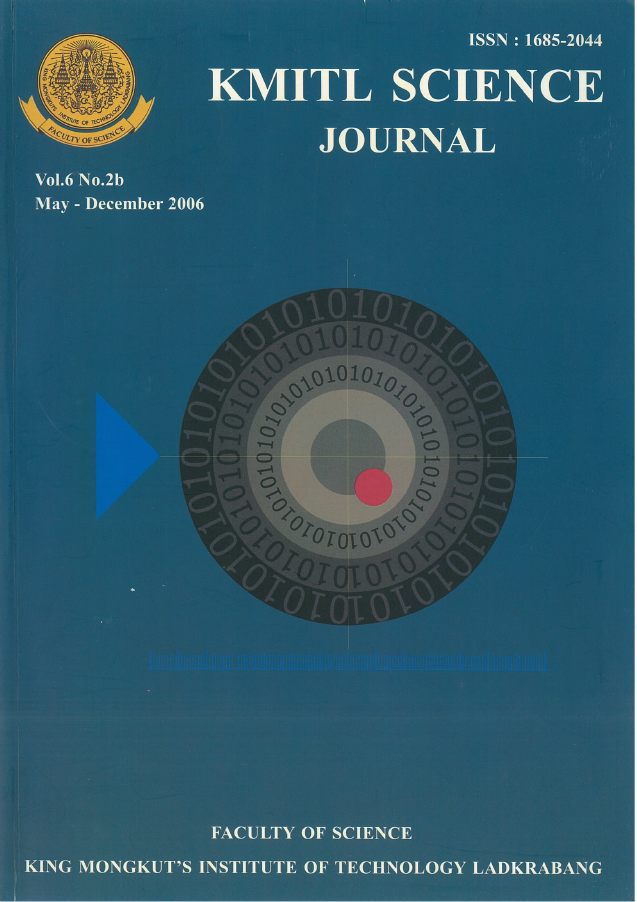Monascus Pigment Formation in Cassava Liquid Waste Under Various Agitation Speeds
Main Article Content
Abstract
Growth and pigment formation of a fungus Monascus KT066 were studied in a 2-L stirrer tank fermenter at various agitation speeds (200, 500, 700, and 900 rpm). A cassava decanter liquid waste was used as a fermentable substrate. At an agitation speed of 200 rpm, long aggregated mycelia were observed with high cell mass (5.1 g/l) but low pigment yields, 0.028, 0.016, and 0.015 unit/g. substrate of yellow, orange, and red pigment, respectively. At higher agitation speeds, 500 and 700 rpm, short branched mycelia were observed with cell mass of 4.0 and 5.6 g/l, respectively. The pigment yields of yellow, orange, and red pigment at 500 rpm were 0.035, 0.032 and 0.034 and at 700 rpm were 0.044, 0.042, and 0.040 unit/g.substrate, respectively. At the highest agitation speed (900 rpm), mycelium appeared to be damaged by mechanical shear forces since short and broken mycelia were found dominated in the culture broth. The lowest cell mass and pigment yields were also observed at this agitation speed. The results showed that 700 rpm seem to be suitable agitation speed for growth and pigment formation of Monascus KT066 in a solely cassava decanter liquid waste. When Monascus KT066 was cultivated in an adjusted cassava decanter liquid waste (C:N ratio = 70:1) at 700 rpm, the growth increased to 16.1 g/l and the pigment yields of yellow, orange, and red increased to 0.166, 0.189, and 0.197 unit/g.substrate, respectively.
Keywords: Monascus, fungal pigment, agitation speed, stirrer tank fermenter, cassava liquid waste
Corresponding author: E-mail: aporn.won@kmutt.ac.th
Article Details
Copyright Transfer Statement
The copyright of this article is transferred to Current Applied Science and Technology journal with effect if and when the article is accepted for publication. The copyright transfer covers the exclusive right to reproduce and distribute the article, including reprints, translations, photographic reproductions, electronic form (offline, online) or any other reproductions of similar nature.
The author warrants that this contribution is original and that he/she has full power to make this grant. The author signs for and accepts responsibility for releasing this material on behalf of any and all co-authors.
Here is the link for download: Copyright transfer form.pdf
References
[2] Lin, C.F. and Demain, a.L.C. 1991 Effect of Nutrition of Monascus sp. on Formation of Red Pigments. Applied Microbiological Biotechnology 36, 70-75.
[3] Steinkras, K. 1978 Handbook of Indigenous fermented foods. New York, Marcel Dekker.
[4] Kim, H.J., Kim, J.H., Oh, H.J. and Shin, C.S. 2002 Morphology Control of Monascus Cells and Scale-up of Pigment Fermentation. Process Biochemistry, 38, 649-655.
[5] Yongsnith, B., Tabloka, W., Youngmanitchai, W. and Bavavoda, R. 1993 Culture Condition for Yellow Pigment Formation by Monascus sp. KB10 Grown on Cassava Medium, World Journal of Microbiology and Biotechnology,. 9(1), 85-90.
[6] Lee, Y.K., Chen, D.C., Chauvatcharin, S., Seki, T., and Yoshida, T. 1995 Production of Monascus by a Solid-Liquid State Culture Method, Journal of Fermentation and Bioengineering,. 79(.5), 516-518.
[7] Baedyanonda, S., Phoolphundh S. and Wongwicharn A. 2000 Production of Monascus Red Pigment from Agro-Industrial Wastewaters International Conference Tropical Agriculture Technology for Better Health and Environment, November 29- December 2. Central Laboratory & Greenhouse Complex, Kasetsart University, Kamphaeng Saen Campus, Nakhon Pathom, Thailand.
[8] http://www.cb.ktb.co.th/prod/brnew.nsf.
[9] APHA, AWWA. 1992 Standard Methods for the Examination of Water and Wastewater. 18th Editions, Edited by Greenberg, A.E., Clesceri, L.S. and Easton, A.D., American Public Health Association, Washington D.C.
[10] Dubois, M., Gilles, K.A., Hamilton, J.K., Rebers, P.A. and Smith, F. 1956 Calorimetric Method for Determination of Sugars and Relative Substances. Analytical Chemistry 28, 350-356.
[11] Miller, G.L. 1959 Use of Dinitrosalicylic Acid Reagent for Determination of Reducing Sugar. Analytical Chemistry 31, 426-428.
[12] Burton, S.A.Q. and Watson-Craik, I.A. 1997 Nitrogen Balances in Landfills. Department of the Environment Contractor Report. Report No. CWM A125b/97. Waste Management Information Bureau, Abingdon, Oxfordshire.
[13] Bernfeld, P. 1955 Amylases. Methods in Enzymology. 1, 149-158.
[14] Lee, Y.K., Lim, B.L., Ng, A.L. and Chen, D.C. 1994 Production of Polyketide Pigments by Submerged Culture of Monascus: Effect of Substrate Limitations. Asia Pacific. Journal of Molecular Biology and Biotechnology, 2, 21-26.
[15] Pastrana, L., Blanc, P.J. Santerre, A.L.., Loret, M.O.. and Goma, G. 1995 Production of Red Pigments by Monascus rubber in Synthetic Media with a Strickly Controlled Nitrogen. Process Biochemistry, 30(4), 333-341.
[16] Turner, W.B. 1971 Fungal Metabolites, Academic Press, London, pp. 136-139.
[17] Wong, H.C., Lin, Y.C., and Koehler, P.E. 1981 Regulation of Growth and Pigmentation of Monascus purpureus by Carbon and Nitrogen Concentrations. Mycologia, 73, 649-654.
[18] Wongwicharn, A., McNeil, B. and Harvey, L.M. 1999 Effect of Oxygen Enrichment on Morphology, Growth, and Heterologous Protein Production in Chemostat Cultures of Aspergillus niger (B1-D). Biotechnology and Bioengineering, 65, 416-424.


